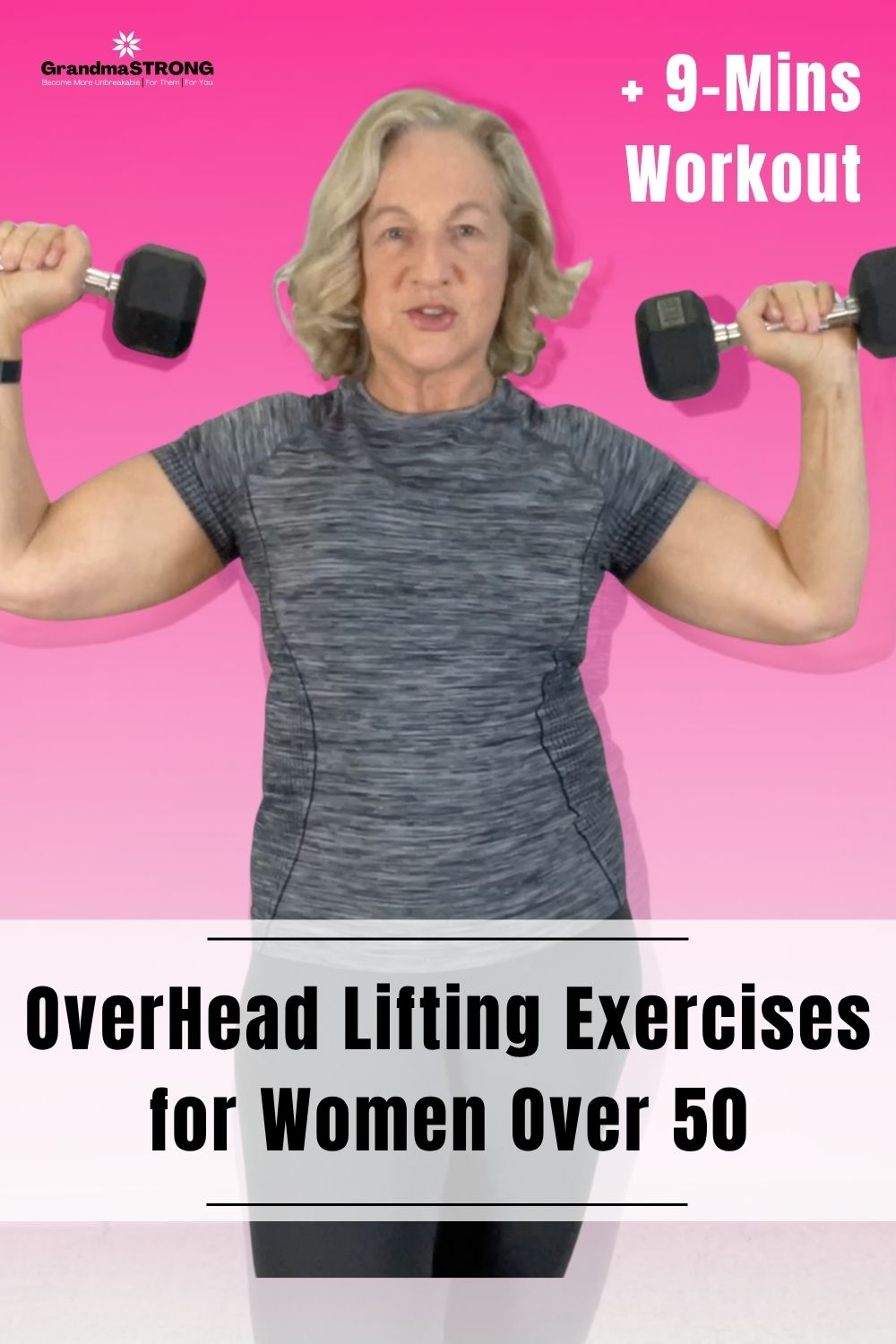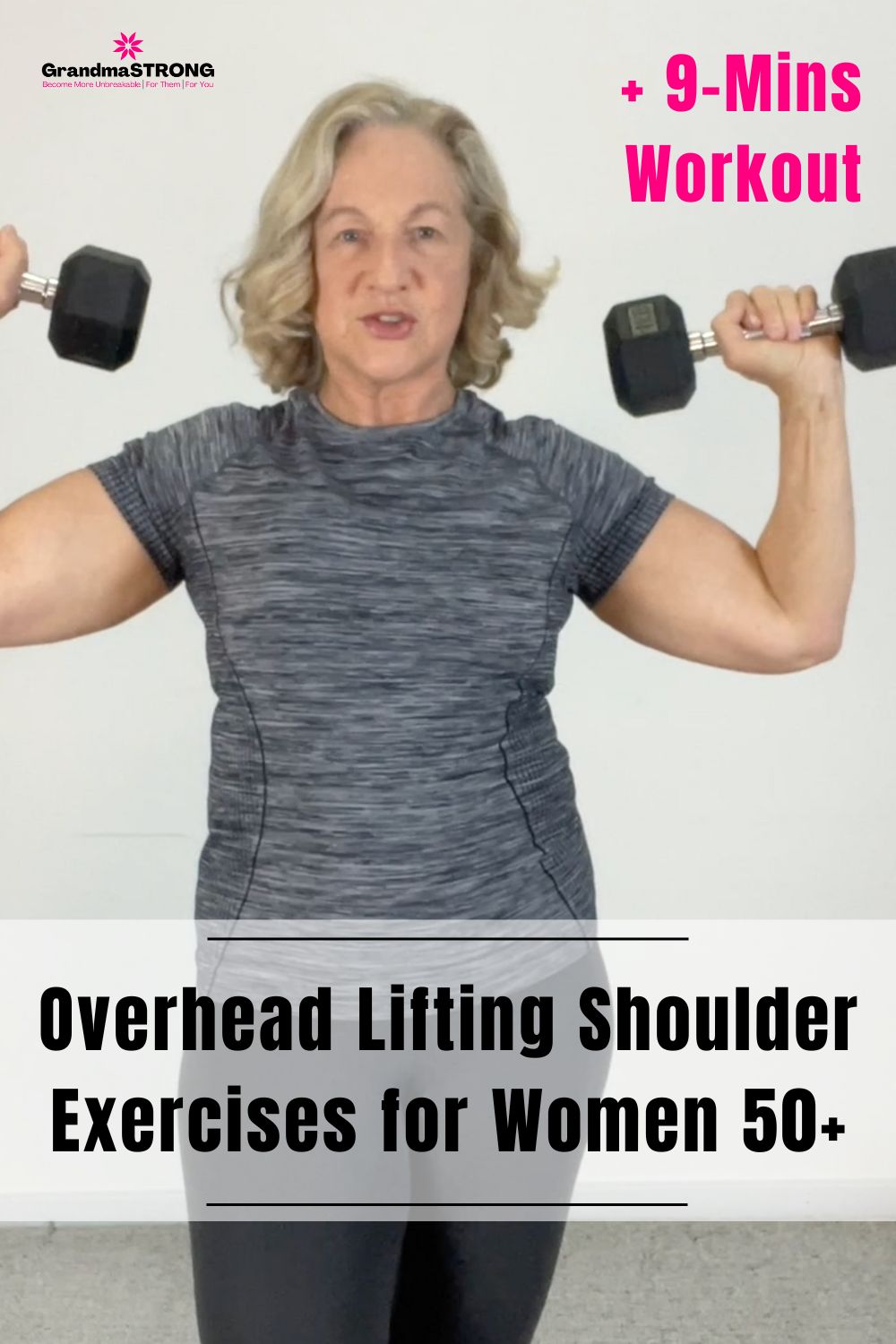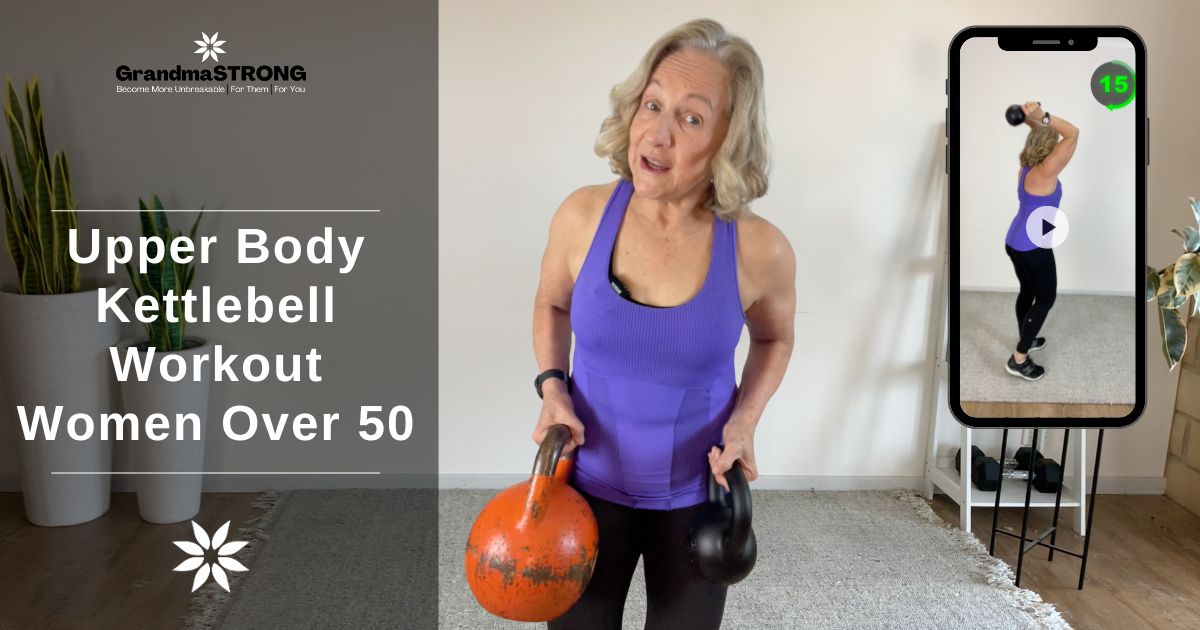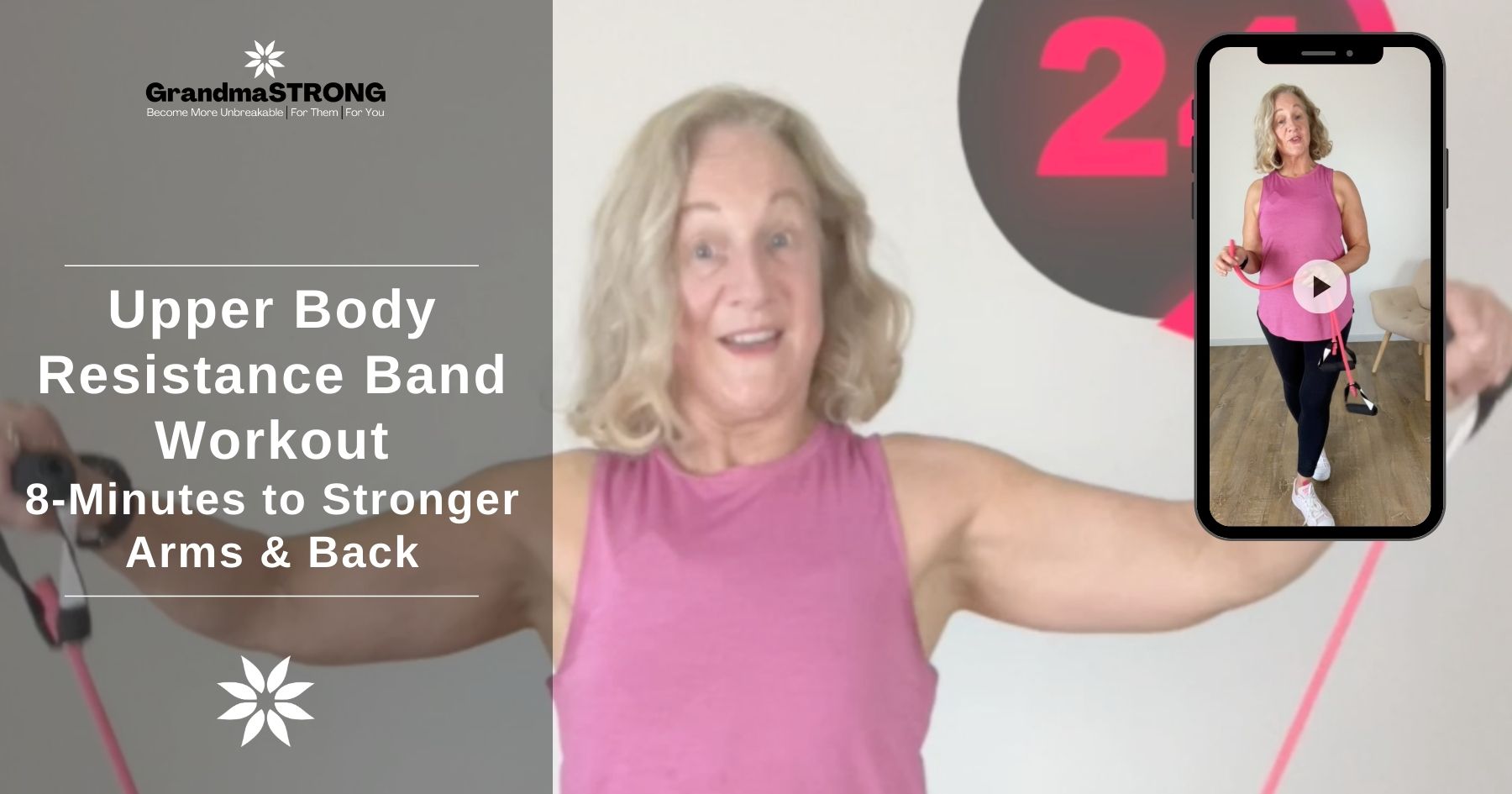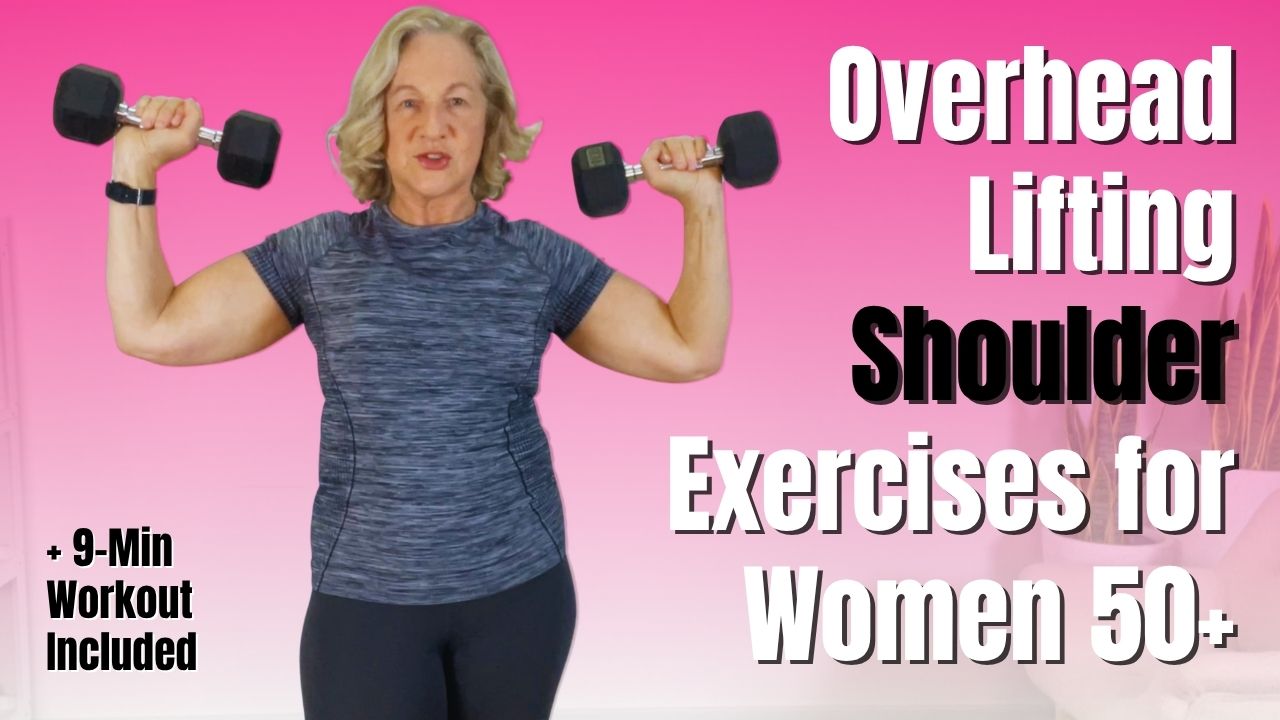
Hey, today I'm talking on overhead lifting, overhead-press, or put more simply, shoulder exercises for women over 50. It's one of those moves that's something that we don't think about too often until we need to do it.
Now, I don't know about you, but I love lifting my grandkids up from the ground, up onto my shoulders and taking them for a ride, but I'm also very much an outdoorsy person and I need to get my kayak onto the roof rack and I want to be able to do that without relying on anyone else to do it for me.
So, if reaching overhead feels harder than it used to, or if you're worried about lifting up safely, you're not alone.
But here's the truth, pressing overhead isn't just an exercise, it can impact on our ability to get things back onto the high shelf in the kitchen or that suitcase in the overhead lockers on the plane.
In today's video, we'll walk through the how-to of doing an overhead press, along with some shoulder mobility exercise to build strength and improve shoulder mobility, and then we'll put it all together in a five-minute workout that you can do right at home.
Let's get into it.
Watch: Overhead Press for Women Over 50: Strength, Mobility & Workout (20mins)
Press play or keep reading, either way, you’ll master this essential ADL move in under 20 minutes.
Ready, let's jump deeper into the 'Overhead Lifting Shoulder Exercises for women Over 50' lesson:
So, in this post along with the why, you'll learn some overhead lifting 'Overhead-Press' exercises you can do at home, and then we'll wrap up with a simple nine-minute at-home workout that keeps you lifting well and pain-free.
WHY Overhead Lifting 'Overhead-Press' Matters + Real-Life Implications:
Now, whether it's lifting the grandkids onto your shoulders, putting that suitcase into the overhead plane locker, overhead lifting is a very powerful tool in your strength toolbox. Let's have a look at the different different real-life overhead-press scenarios, along with how you can strengthen your shoulder lifting ability .
1. Lifting the slow cooker back to the top shelf:

Real-life Example: You’re trying to lift a heavy casserole dish back into the top kitchen cupboard. You wobble. Your shoulder pinches. So you leave it on the bench instead.
Why's it's Important: Losing strength and mobility overhead makes everyday tasks feel harder, and riskier. The more you avoid reaching high, the more strength you lose. And that leads to needing help with basic things like storing groceries or packing for a trip.
Women in a 12-week chair-press program got stronger hands and scored higher on the self-care part of the daily-living test (they could manage cupboards and dressing alone).
2. Lifting a backpack or bag into an overhead locker:
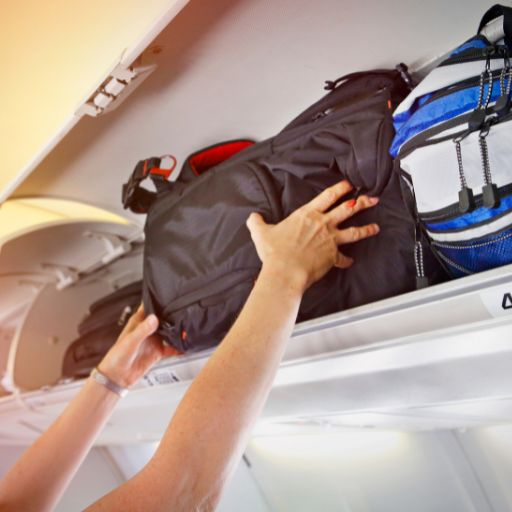
Real-life Example: You’re getting on a plane or bus and go to stow your bag overhead. It feels like a struggle. You look around for help, hoping someone sees you need it.
Why's it's Important: Overhead pressing builds shoulder, arm, and core strength. That’s what gives you the control to lift a bag and hold it there, without straining your neck or arching your back.
A review of 30+ studies found resistance moves that involve pressing and reaching boost upper-body strength and balance in adults over 60.
3. Hanging out washing or washing windows:
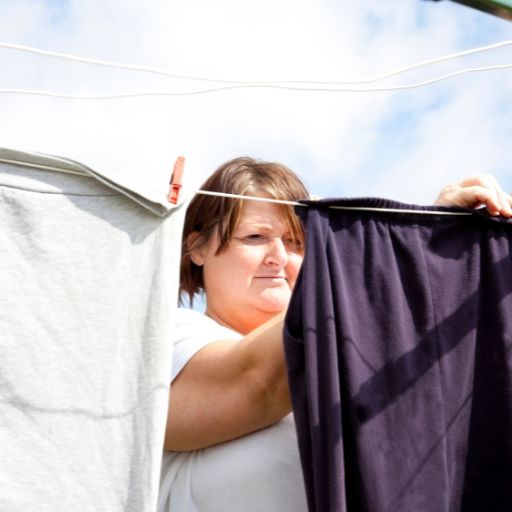
Real-life Example: You try to reach high to peg a sheet or clean the bathroom mirror and feel tightness through your shoulders - or worse, your back starts to ache from leaning.
Why's it's Important: The ability to reach comfortably overhead relies on shoulder mobility and upper-back posture. If you stop using that motion, the body stiffens and compensates in all the wrong places..
A falls prevention study revealed that regular strength work that includes shoulder pressing cuts fall risk by sharpening balance and whole-body control.
4. Lifting a kayak or bike onto a roof rack:
Real-life Example: You’ve still got adventures left in you, but when it’s time to lift the kayak or roof box onto the car, your arms feel too weak or unstable to do it safely.
Why's it's Important: Overhead strength = independence. If you want to keep doing the outdoor stuff you love, you’ve got to train the movement pattern that supports it.
In a study of retirees it was revealed that one year of heavy resistance training around retirement age locked in muscle strength four years later, it stuck!
5. Lifting a grandchild up high:
Real-life Example: You want to lift your grandchild overhead and give them a giggle, but your shoulders don’t feel strong enough, or you’re scared of tweaking something, or worse dropping them.
Why's it's Important: This isn’t just strength training. It’s life training. Keeping that overhead strength means keeping those joyful moments. And feeling strong enough to say yes more often.
Same studies as listed and linked above show stronger arms equal better active-daily-living scores and more confidence moving through life.
#1: How To Overhead Press - Beginner Technique in Detail
Today, I'll mainly be doing mine with a kettlebell. It's my favourite piece of equipment, but I'll be doing some with dumbbells as well. It's basically the same kind of thing.
1. Wrist Position:
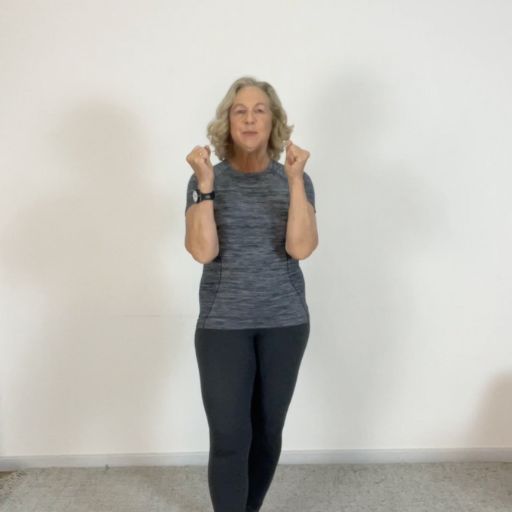
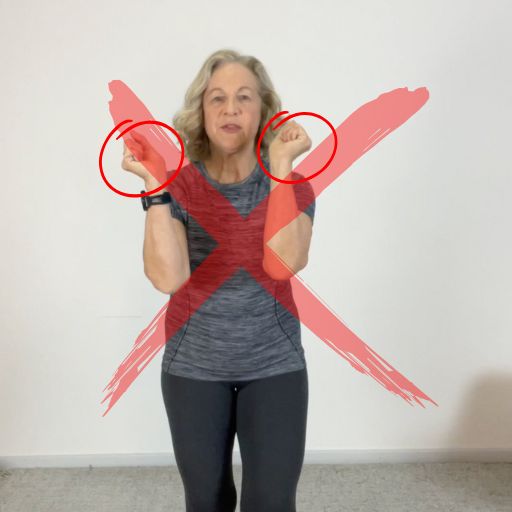
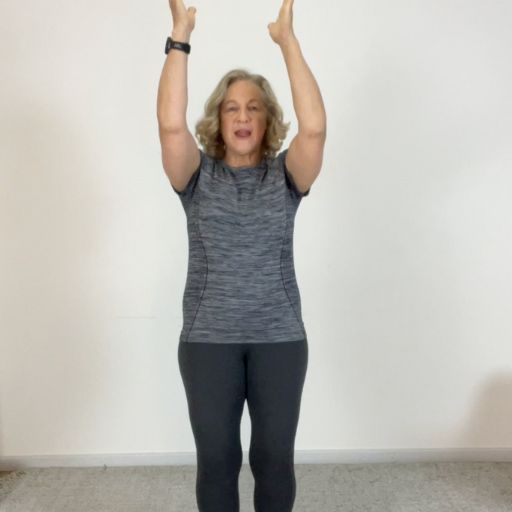
- So, you want to keep your wrists in line
- Don't let them bend either way
- You want to be taking it straight up overhead.
2. Single, Both Arms & Core Activation:
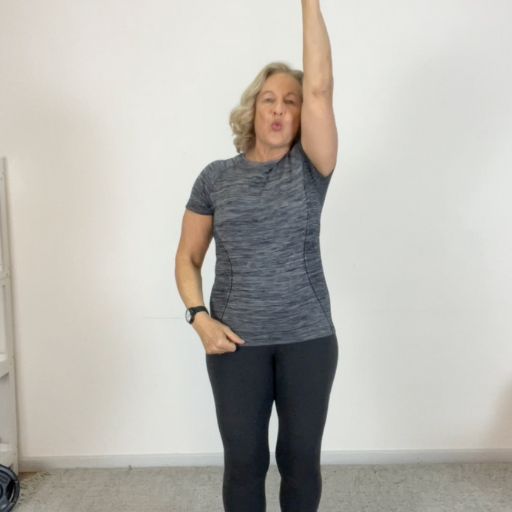
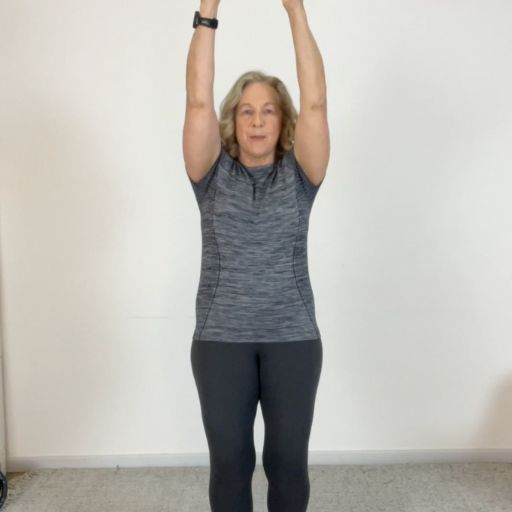
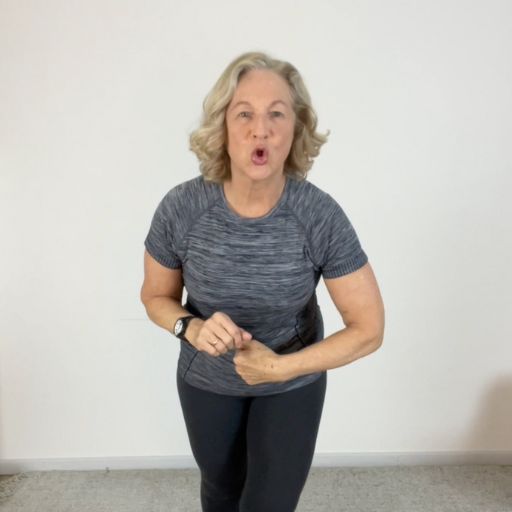
- So, you want to be able to lift up overhead, whether it's a one arm, one arm
- Or two arms, you want to be able to lift up overhead
- Pulling that core on. So, a little activation of the core before we lift
3. Keeping Shoulders down - No Shrugging:
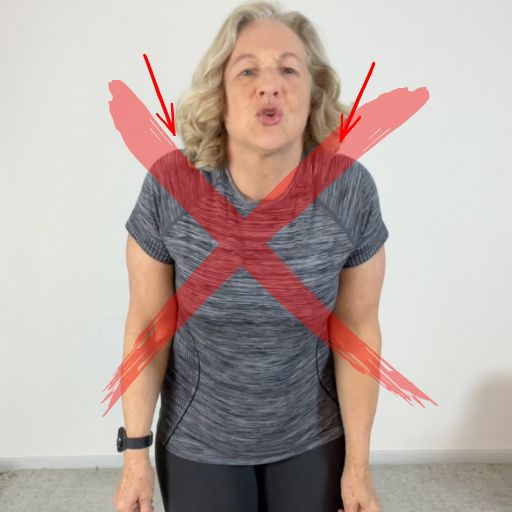
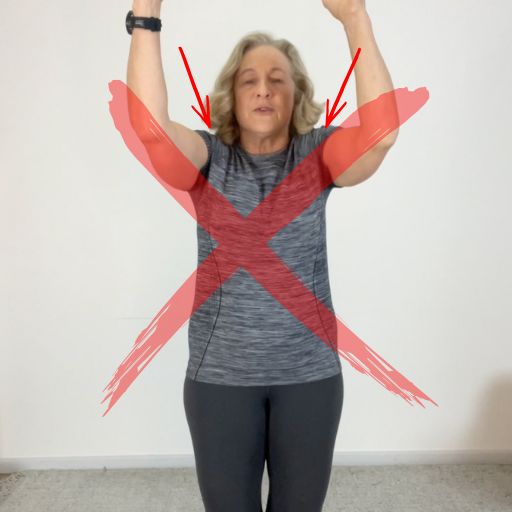
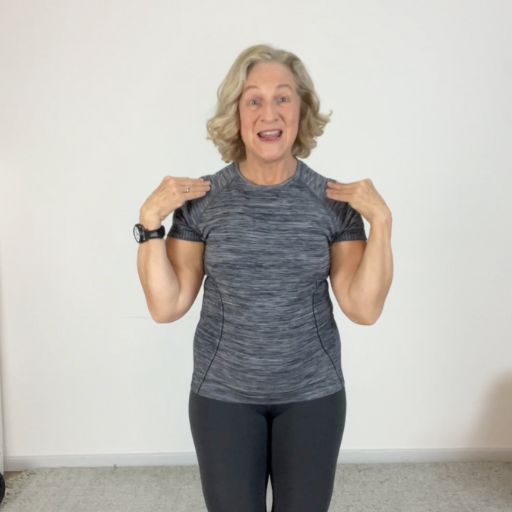
- We make sure that we don't shrug the shoulders while we're there
- So, we're not going to shrug these shoulders.
- These shoulders are staying down and away from our ears
- NOTE: Really important, actually, even if we do upright rows, overhead press, we have to make sure those shoulders don't follow. Those shoulders stay down and away from the ears at all times. So, when we press, those shoulders are not following.
4. Pelvic Tilt & Arms Straight Up:
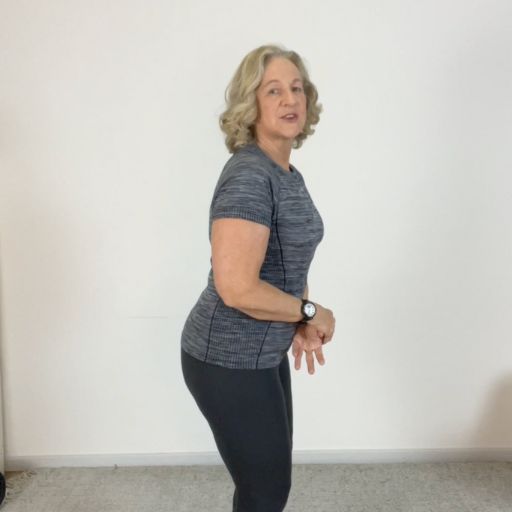

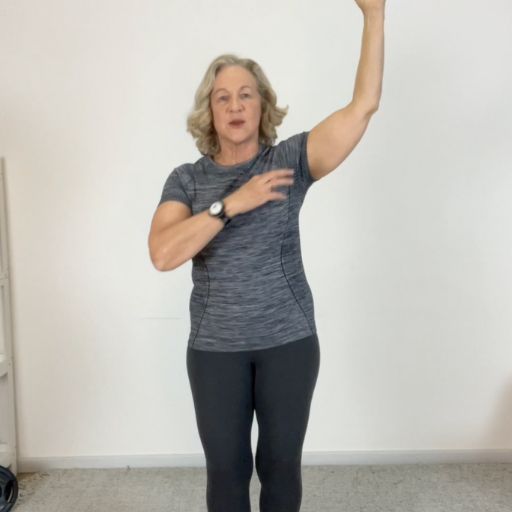
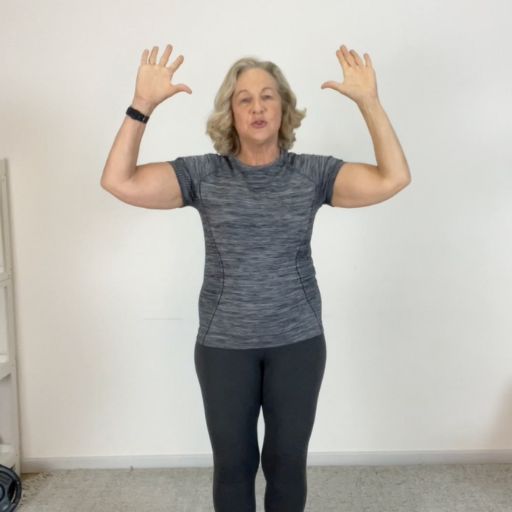
- We want to keep our ribs down and our pelvis slightly tucked
- So, a slight sort of tuck under with that pelvis so that we keep everything nice and taut right through that torso
- We are lifting straight up and not away from the body
- So, potentially, when you get into bigger weights and you want to do that overhead press, we're not kind of out here or pull a lot of strain on that shoulder
- NOTE: Now, there's certain types of presses we do come out here and we can lift, but with our kettlebell, they will be going straight up. So, straight line, straight up, and we need to make sure that that core is on when we do it.
5. Don't Arch the Back:
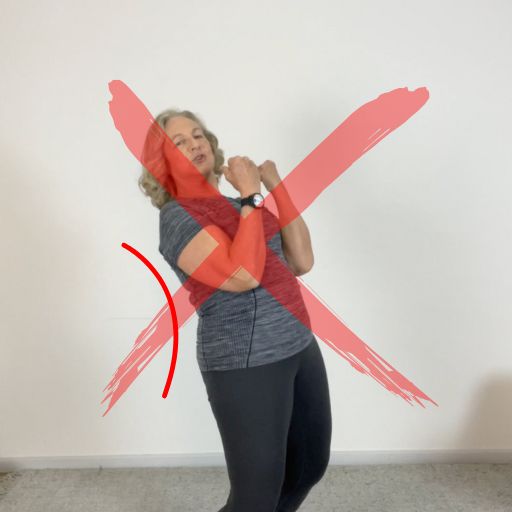
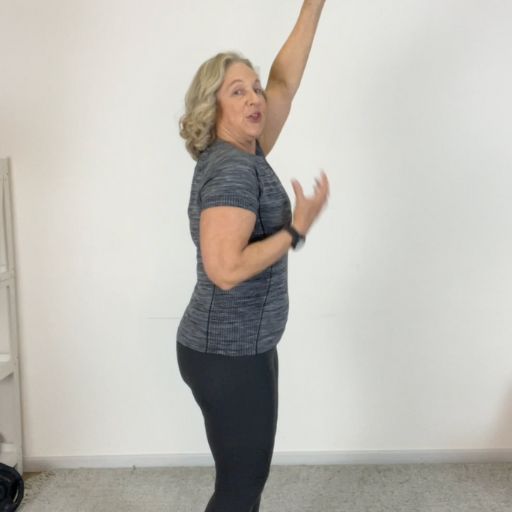
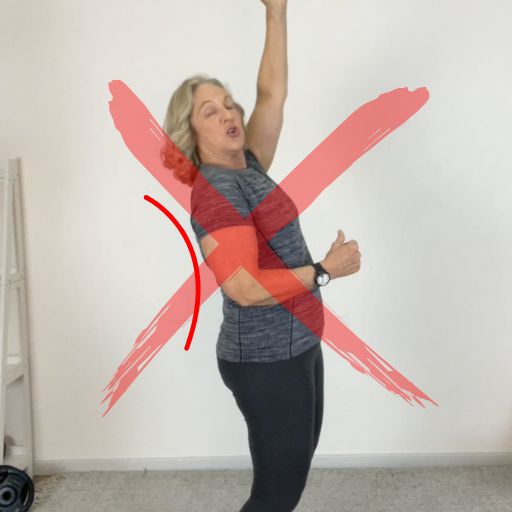
- We don't want to arch the back
- It's not what we want to do as we lift. We want to be able to lift and everything is staying straight. We're not trying to bend back.
- So, when you see these guys in the gym and they're looking good and looking at their muscles in the mirror, and you often see them, you know, lifting a big weight, maybe a bicep curl, and they do that big lean back.
- NOTE: And if you're somebody that does arch back or you have not a good back, and you do want to start doing a bit of overhead pressing and getting better at it, your first option might be to go on the chair and sit in a chair because that will take out that lower body part of it that you're not needing to think about.
6. Squeezing - Activating the Glutes:
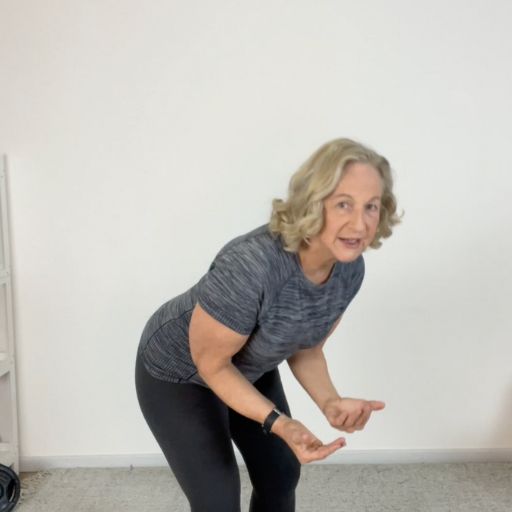
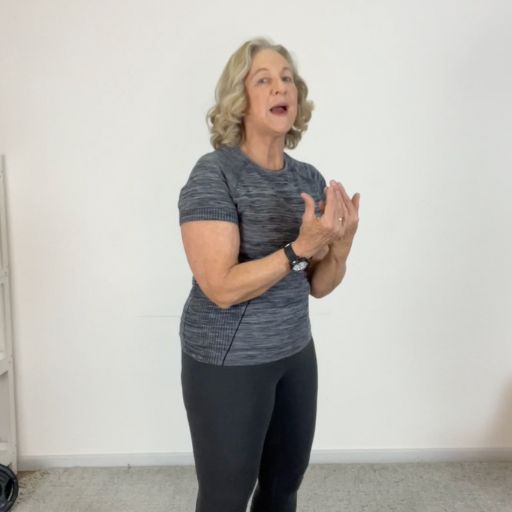
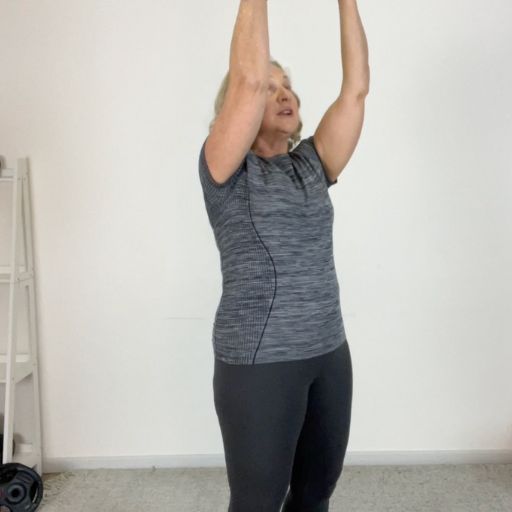
- As you lift as well, you want to think about squeezing the glutes
- So, we think whether it's a deadlift and we've gone forward coming up, you want to squeeze
- Whether it's a lift up and coming back down, you want to squeeze because we want to turn everything on that we can turn on to make that press a good press.
7. Arthritic Wrist Dumbbell Positions:
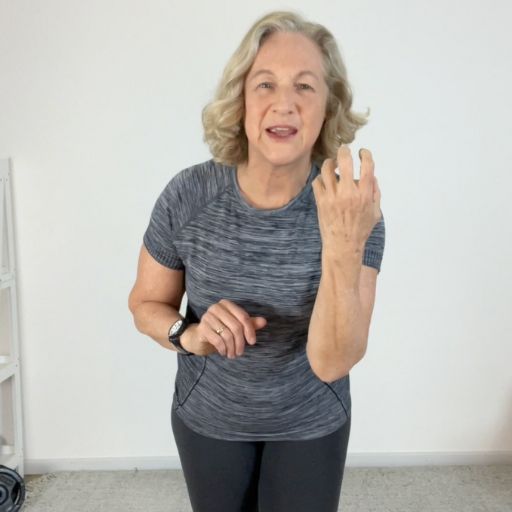
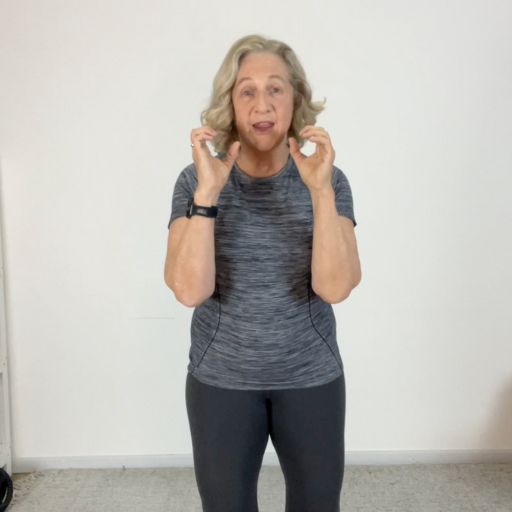
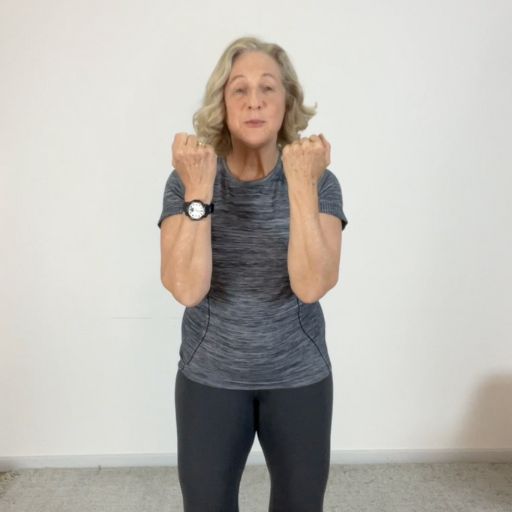
- Dumbbells can be better for people with rheumatoid arthritis because you're going to be able to get a better grip and make sure that wherever you're holding that is going to be a nice hold for you
- So, it may be that you do an overhead press with your dumbbells with your hands at right angles to your body
- Maybe you prefer it with hands parallel to your body, although most likely not because of the shoulders, probably most people there, but you may have slight variations on all that
- NOTE: There's no strict criteria, but certainly for somebody with arthritis with limited range of motion of the hands, probably something smaller like dumbbells, but you can also be doing a bigger dumbbell, but just something a bit easier to hold.
8. How to Breath During The Press Movement:
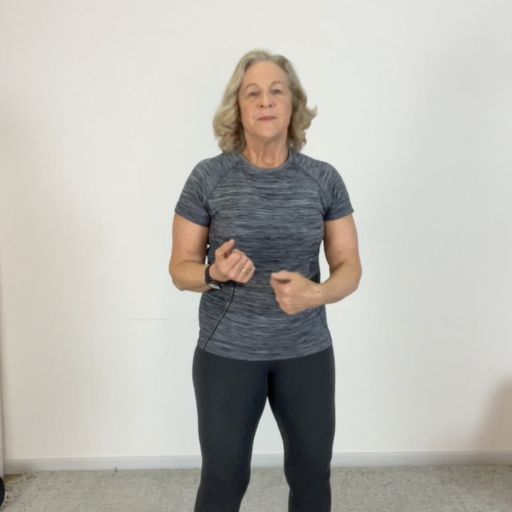
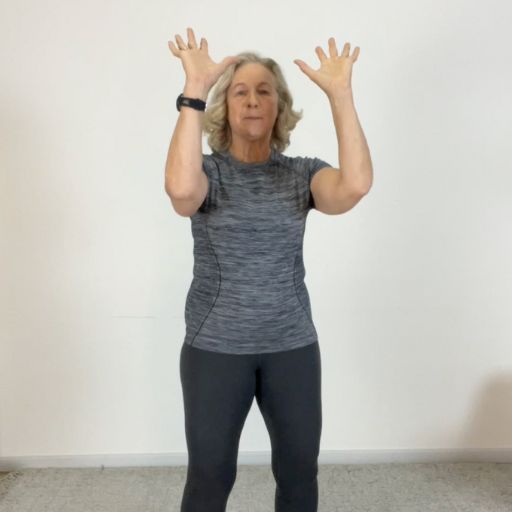
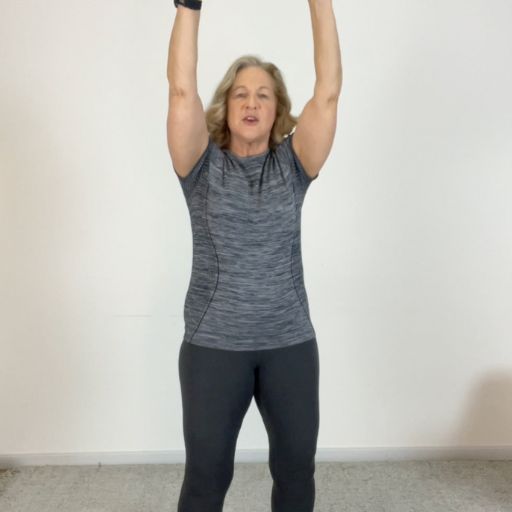
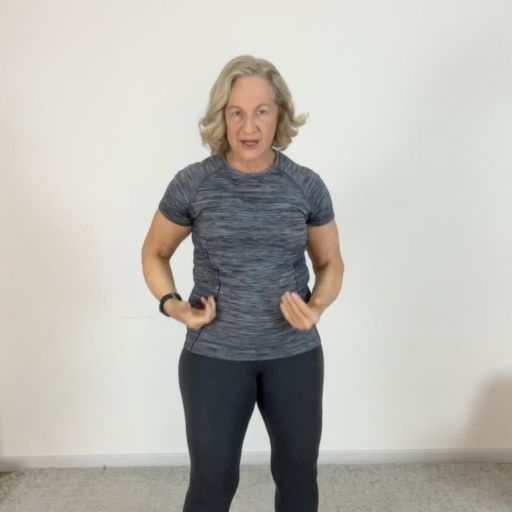
- So, a little breath in and then turning this core on
- And then as we get partway up, you can let that air out
- Breath in before we come down, turn the core on and then down again
- NOTE: So, we're doing the out breath on the effort, but particularly we want that core turn on as we take it up
9. Everything is in Control:
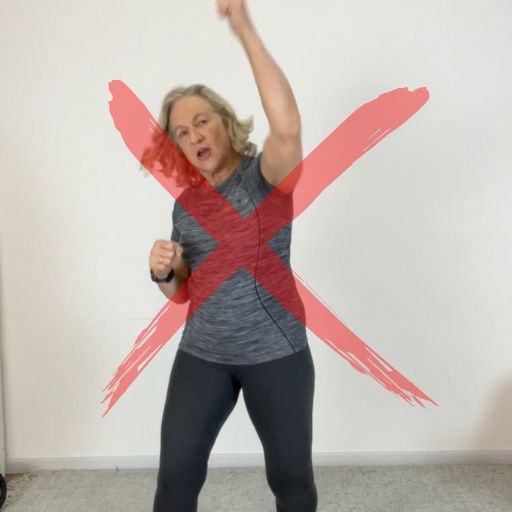
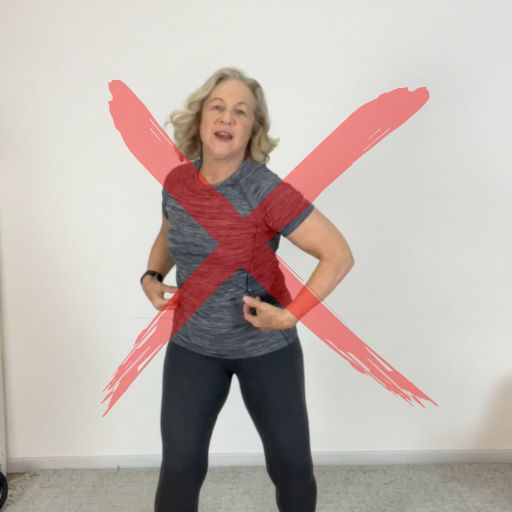
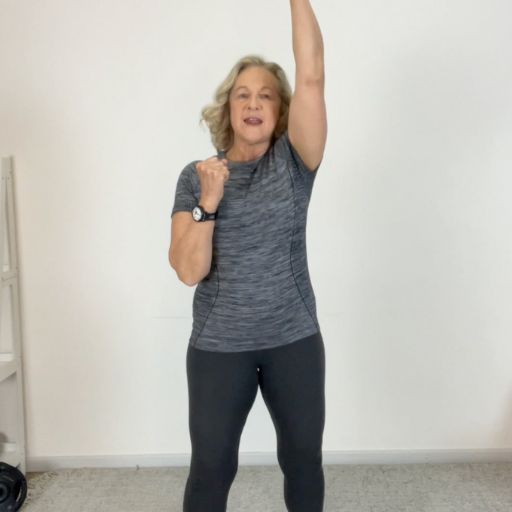
- So, don't just throw the weight up any old how
- Or, get kind of all wobbly around the core letting everything roll around
- So, everything's in strict control through the entire movement, and that core is on
10. Keep Arm in Alignment:

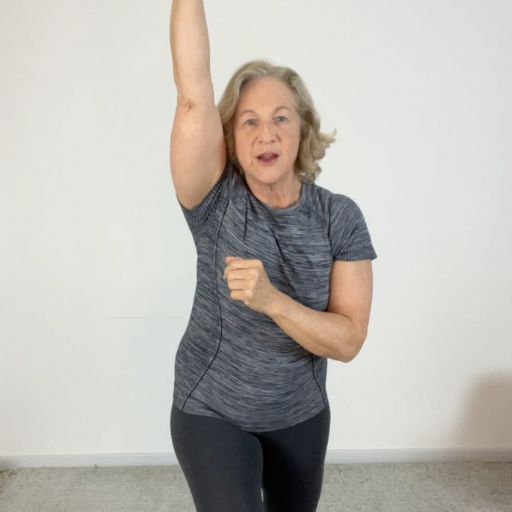
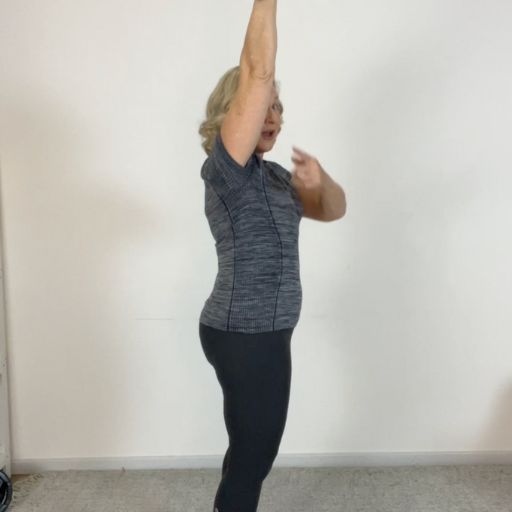
- And as we press
- We want to come up so that this bicep comes right up by the ear. If you've got a kettlebell there, you want to stay as safe as you can
- And if I turned onto the side and came up, it should all be in line, kind of right down the side, down through my hip and down through the outer part of my ankle
11. Individual Weights vs Bar:
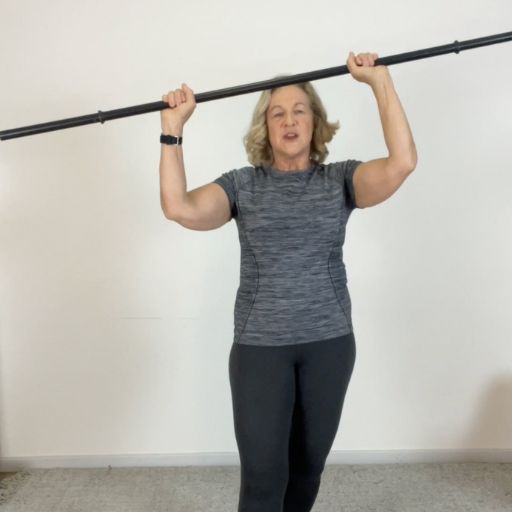
Now, the reason I have had a look at people in classes, because I have been an instructor waiting for the previous class to end before I go in. And it's a really interesting thing.
The reason I'm not really keen on just a bar with weights on the end is if I've got a really strong arm here, and this arm doesn't really quite weak, and I'm doing a lift, I'll probably see quite a few bars that look like that because my stronger side is doing more of the work.
So, what I like about two separate weights is means that your weaker side has to work as well as your stronger side. It just can't rely on the stronger side to do all the work.
So, really interesting to see people who have a very dominant, very strong side on one particular side.
12. Strengthening the Weaker Side:
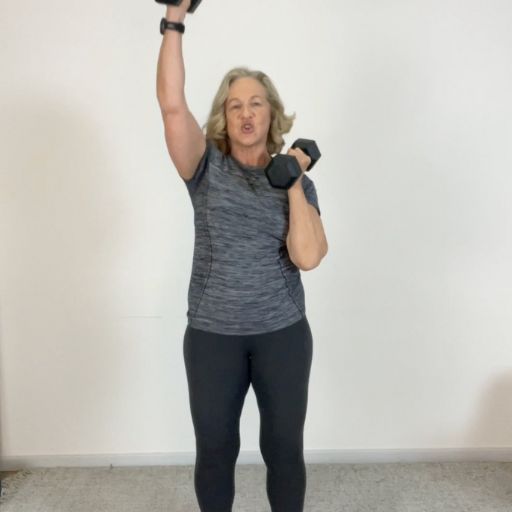
Now, the other thing you can be doing too, if you know that you have a very weak side, as a functional trainer, I'm trying to get people's both sides to work together. So, I used to have a very, very weak left side because I did everything with my right.
And so, I have learnt over the years to make this left side work just as hard. So, now my left side can pretty well do what my right side can. But if you are very much a dominant side, where you're doing all the work on that side, you vacuum clean that side, you lift up the groceries that side, everything is done with that one particular side.
You need to think about using your weaker side first. So, if we're doing a one arm press, they will both have the same weight, but the stronger side will only have what the weaker side can do. So, if the weaker side can do some lifts with a five kilo, and this one can do like an eight kilo, you're going to stick with a five kilo for both.
You're going to do the same amount of reps with both. So, the stronger side will only do what the weaker side can do, because then we balance everything up. And as the weaker side gets stronger, we can start to work everything and make everything work a little bit harder.
13. Pressing with a Dumbbell:
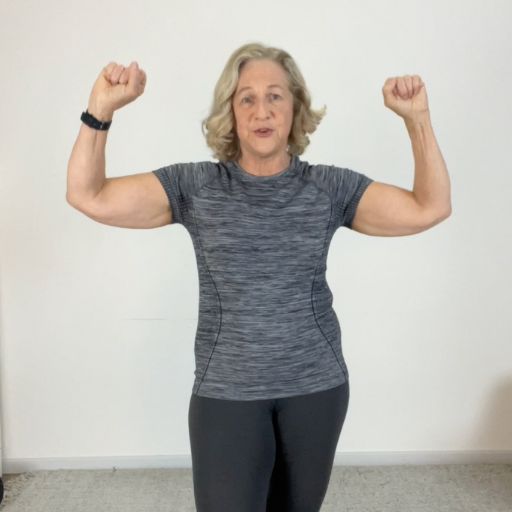
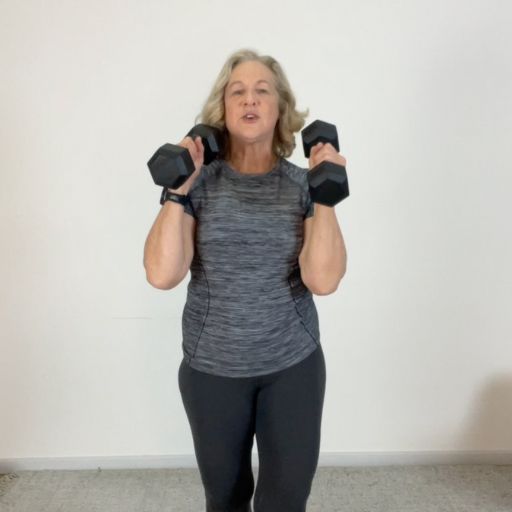

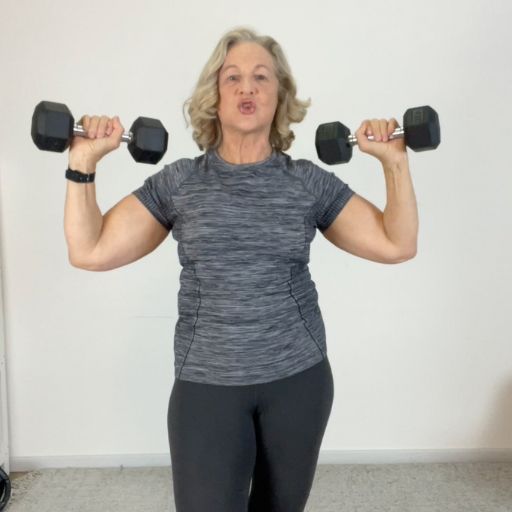
- You can also take those dumbbells out to the side if you did want and do a lift from there and bring it down. But you need to have good shoulders for that
- So, for most of the time, I have my older clients with their hands in this sort of position. So, this sort of position, so that's a really natural position
- So, whether we take both up or one arm up, one arm up, it's much the same. So, this is the sort of position I would probably have for my overhead press
- Both arms out here can be a bit too extreme on those shoulders. So, probably staying safe and keep the arms tucked in to the side
14. Pressing with a Kettlebell:
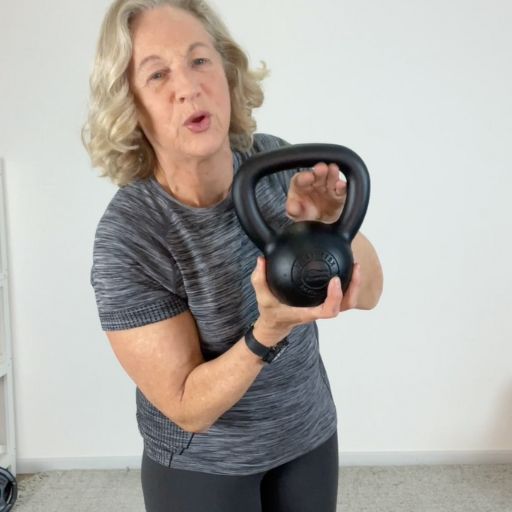
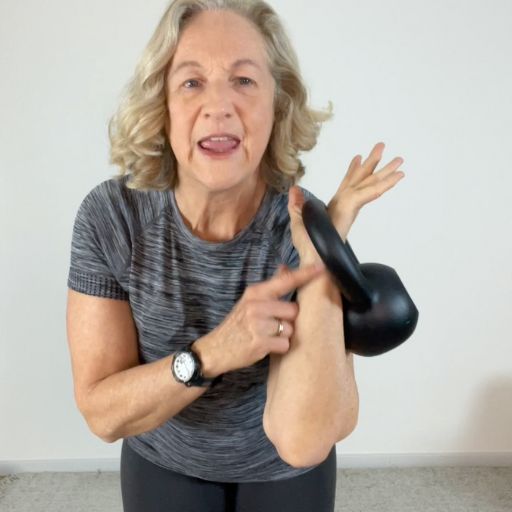
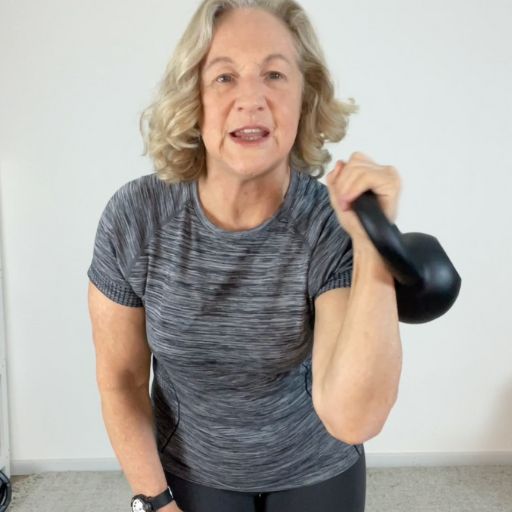
- But for now, let's get our kettlebell and have a look at how we can lift that kettlebell. So, from here, I'm going to grab my kettlebell. It's got the horns on the kettlebell. It's got the window on the kettlebell.
- So, I'm just going to put my hand through here. The kettlebell sort of rests on the end of my palm. I've got my thumb there, but I'm not got a death grip on it.
- Too many people when they do strength training have a real death grip on the bit of equipment that they're using and get really sore hands or the fingers get sore. So, this is a really light grip on here. So, I've got that through there.
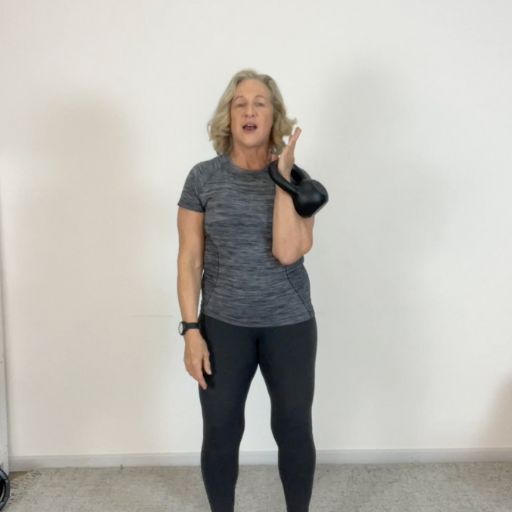
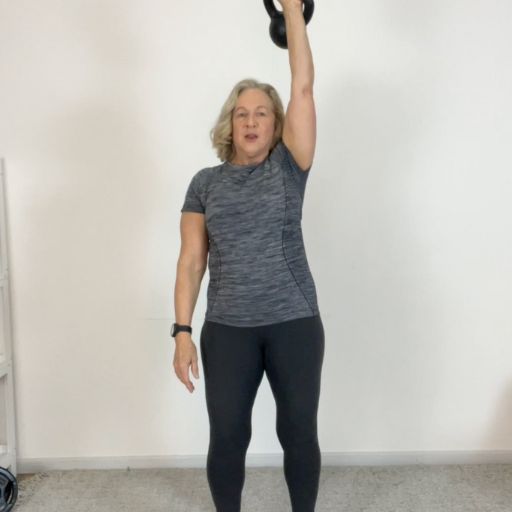
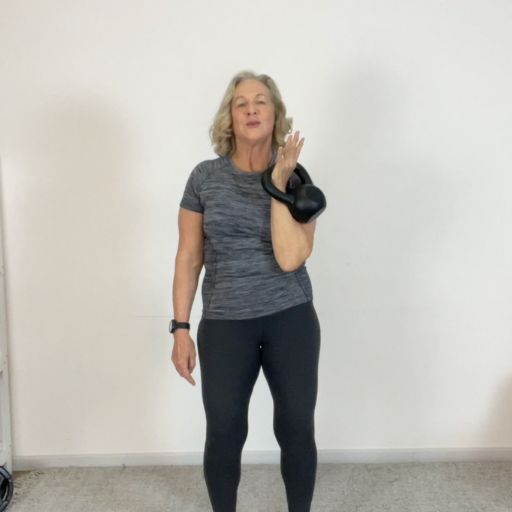
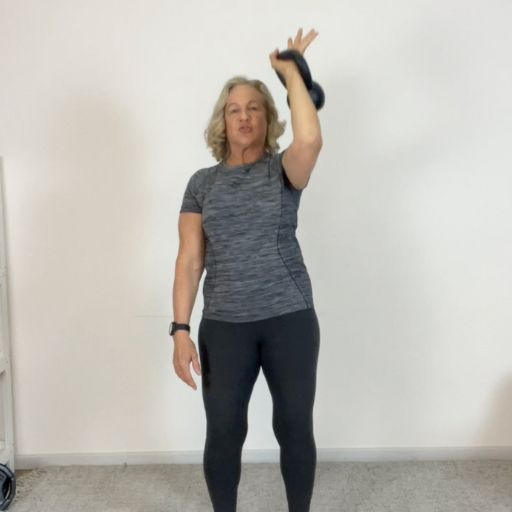
- I'm in the rack position to start with. So, I've got my elbow in by my ribs and it is sitting nicely there. I should feel quite comfortable there. I should feel like I can even walk along with it there. So, we're going to get into an overhead press
- So, think about I'm trying to go straight up here, not trying to go out to the side. I want to be in a straight line
- So, when I come up and come down, this arm internally rotates as it comes down
- As I come up, it's a bit of an external rotation, comes straight back down
- NOTE: So, let's have that core on and a little breath in and great. And of course, hopefully you at home started with your weaker arm. We're going to be doing the other arm, same thing.
So, that elbow is nicely in by our side, tricep kind of lying against our rib. A bit harder if you're a big breasted person, but you're still trying to bring that arm in nice and close. And then squeezing those glutes as you lift as well.
Really holds everything on and that core is on.
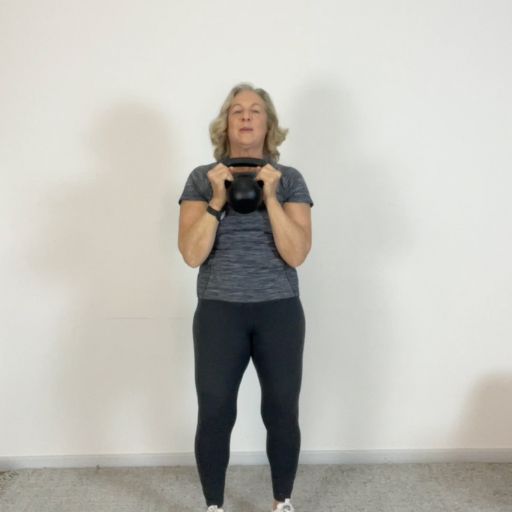
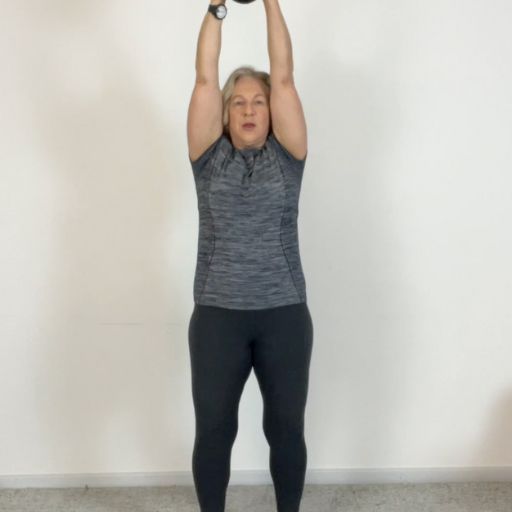
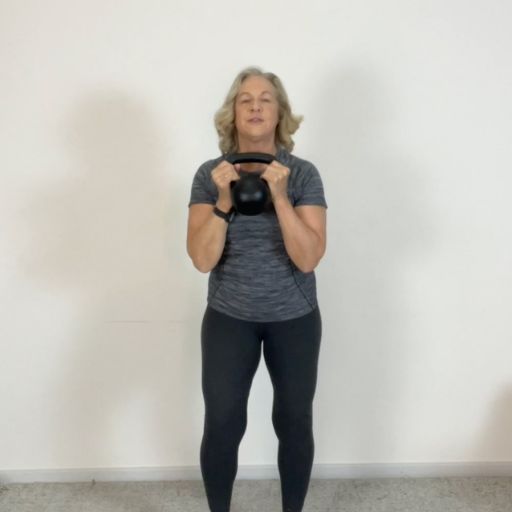
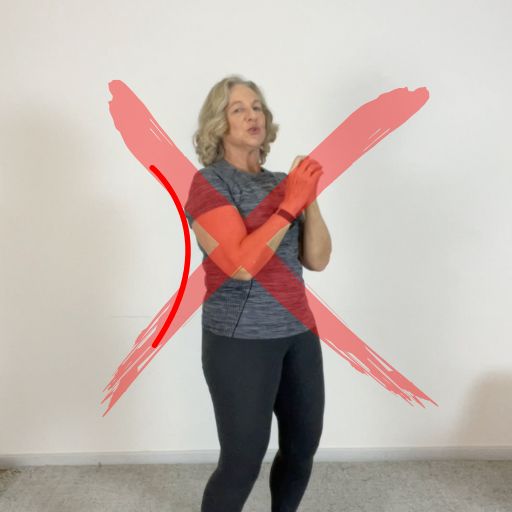
- Now, if we're going to do a press with two hands on it, I usually like to hold the base. So, the base being right down here, down low
- And then from here, I can lift. Same thing again, same thing applies. I'm trying to go straight up and then coming back down
- Straight up, coming back down. Good
- And try not to do that lean back as you do it. So, if you have to lean back, you may be, the weight may be too big for now. So, you may want to go back down to a smaller weight and just do it from there
#2: Chair Assisted Shoulder Mobility
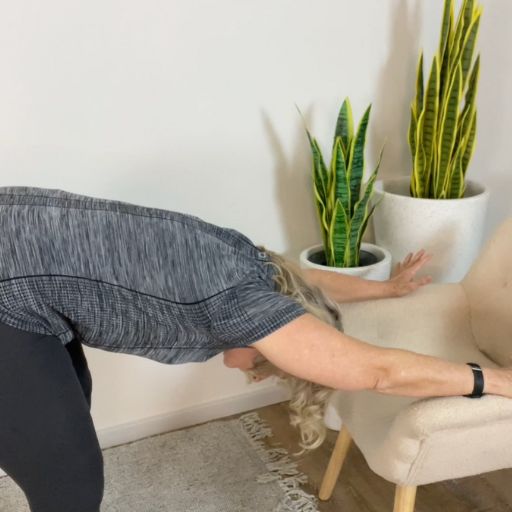
Some simple exercise that can help to give you some mobility. So, this is one of our mobility exercises. You can be doing this on a low table.
You can be doing this on a chair. Just make sure you don't pull the chair over on top of you. But I'm just going to take this, poke my bum right out to the back.
And then I'm dropping my head in between my shoulders. And I can feel a lovely, lovely shoulder stretch there. That feels really, really good.
You can hold that stretch for 30 to 60 seconds.
#3: Doorway Front Pec Mobility Stretch
And now, we're going to have a look at a door stretch.
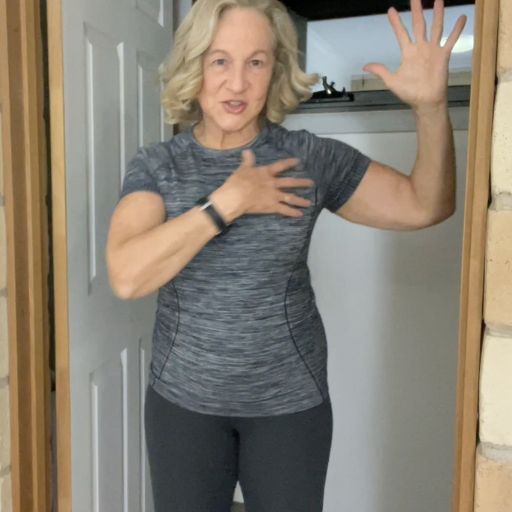
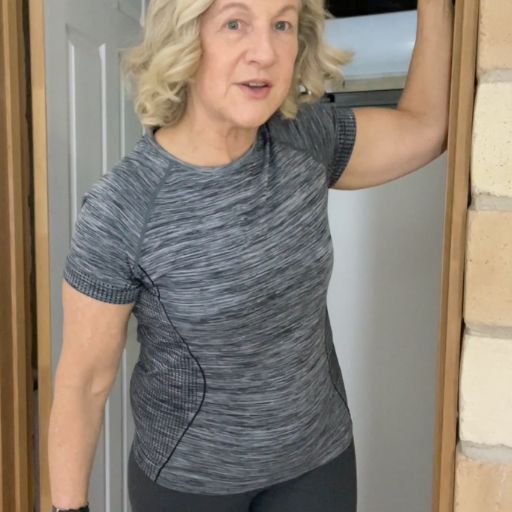
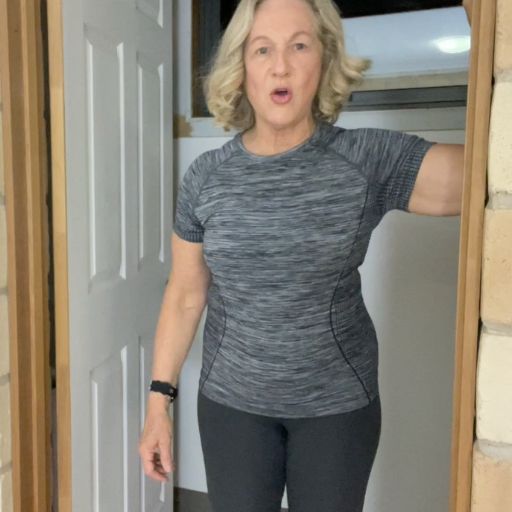
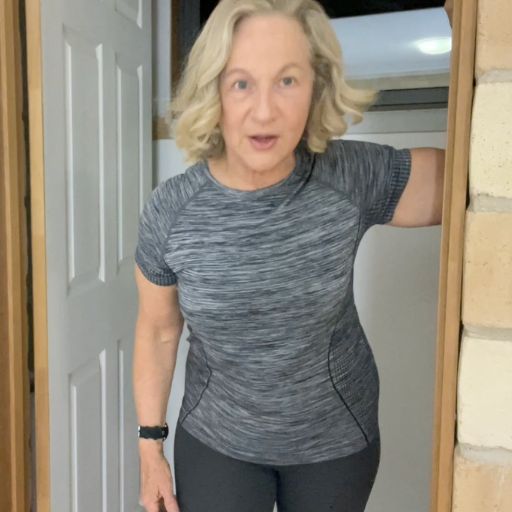
- So, this stretch is to stretch through kind of the pectorals, the front of my shoulder
- I'm just going to put an arm. So, the arm kind of lies inside the door like that. So, my whole arm there
- And I'm just going to have a bit of a lean forward with that
- And I can feel a nice stretch right into the front of my shoulder
#4: Wall Assisted Shoulder Stretch
But we can also do this on the wall. Let's have a peek. So, if you're going to do this on the wall, you're going to face forward to the wall.
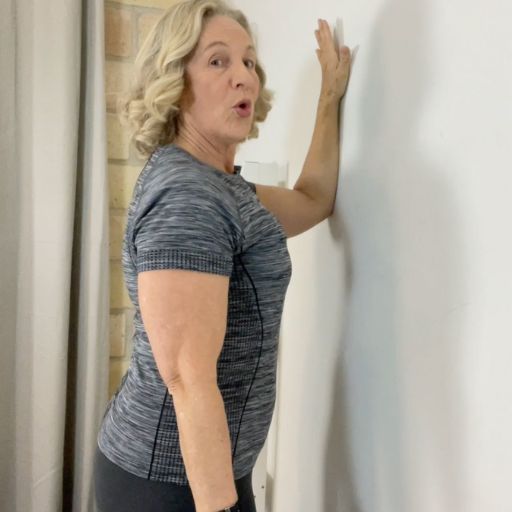
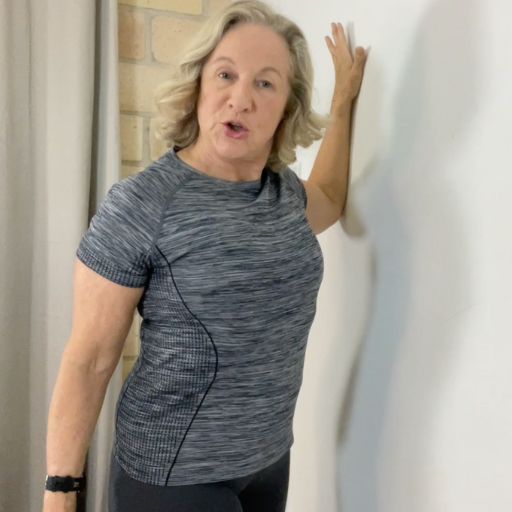
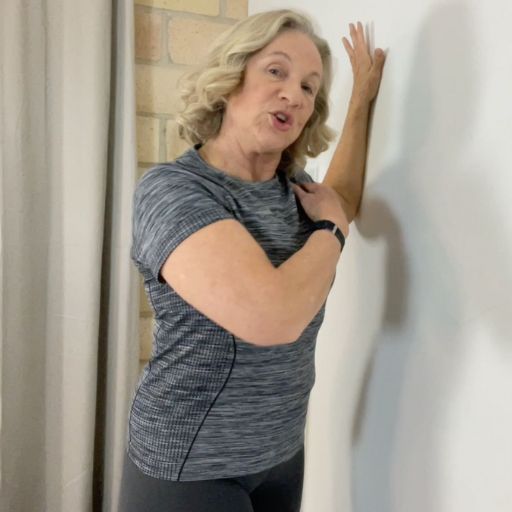
- You can put an arm. So, this part of your arm on the wall. And you're simply going to turn away from the wall
- So, we're going to turn our whole body away from the wall
- And you should be able to feel that nice stretch in the front of that shoulder. Hold again for 20 to 30 seconds and do the other arm. And you might find that one is a bit tighter than the other, but just keep going
#5: Lying Side-to-Side Rotations
Now, this is my floor stretch.
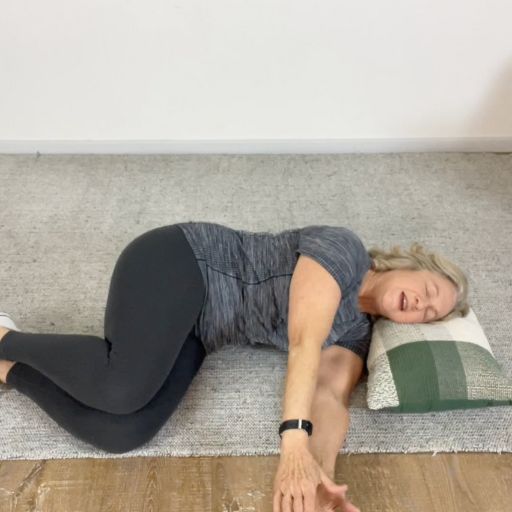
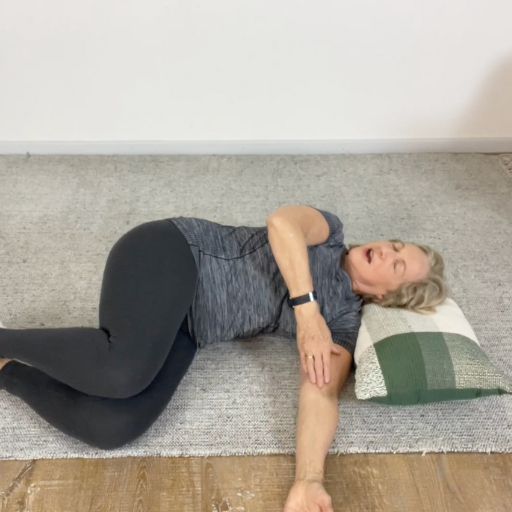
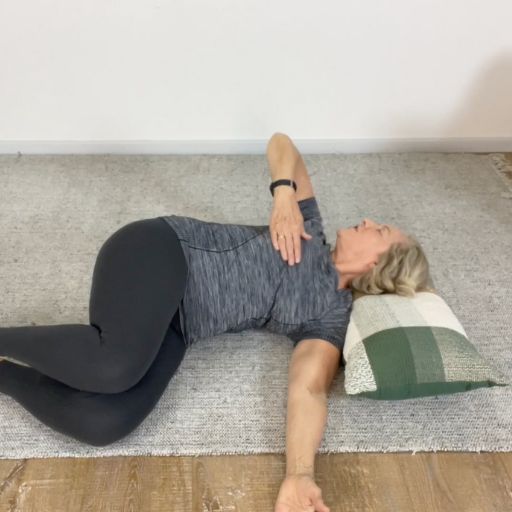
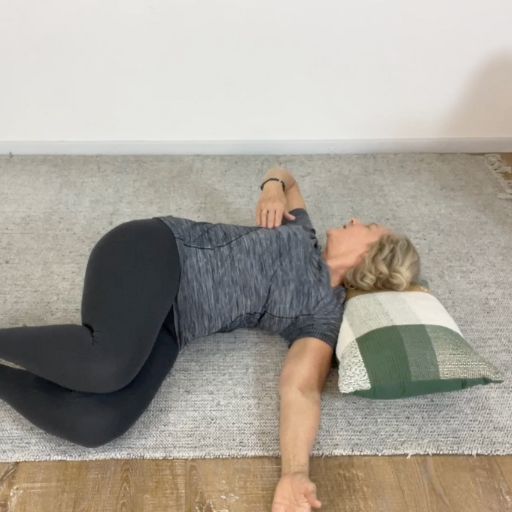
- So, I'm going to lie on the floor with my knees up. Just going to take one arm out here. My other arm is over the top
- Now, we can either slide across, take this elbow right back and look over towards that elbow

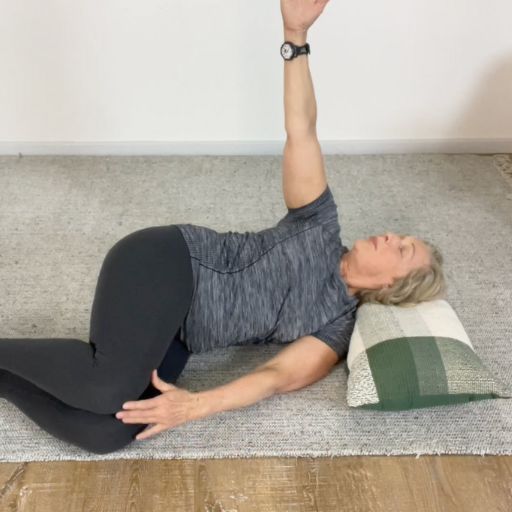
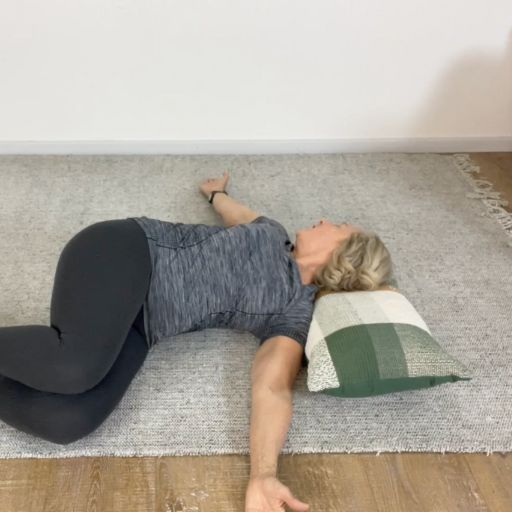
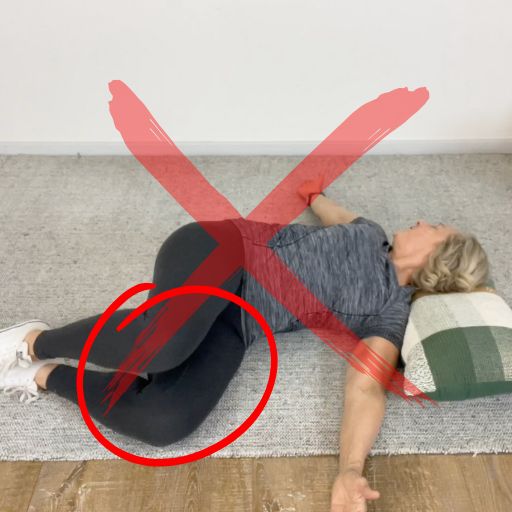
- The other way we can do this is take that arm right up in the air
- Keep these knees down
- Don't let them go and follow that hand the whole time while we take it right back behind
- And making sure you don't lift these knees off the floor. So, they're staying there.
- NOTE: this exercise does help a lot. I used to not be able to touch the floor with my hand. And now, when I do this exercise, I certainly can take this right over there. It's really good.
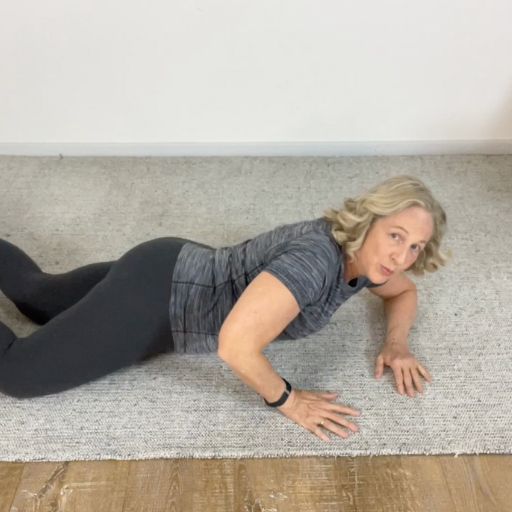
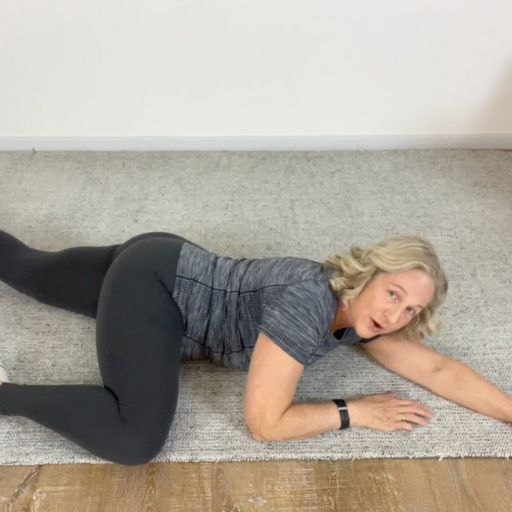
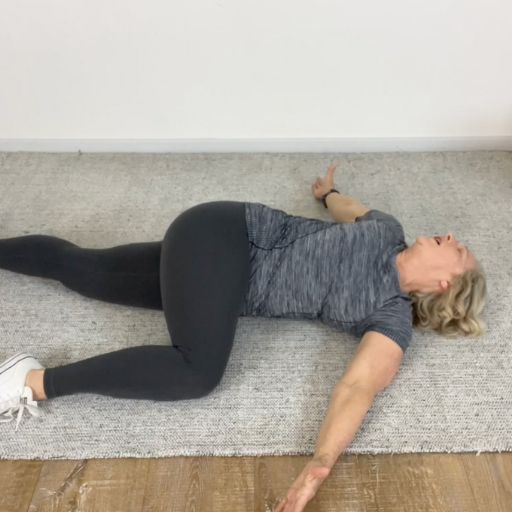
- A couple of other ways to do this while we're already on the floor. One that I quite like is where I'm on my front, take up one knee, take off the opposite hand, so it comes through and facing my knee
- And this other, this knee stays down while this other arm goes over
- This knee does not leave the floor, but it's also a lovely stretch out for that top part of my body. I can feel my shoulder. I can feel my lower back. And it also actually does a lovely stretch into the front of that shoulder that's lying back. So, you get kind of a full back and arm one. And of course, when you do one side, you'll do the other
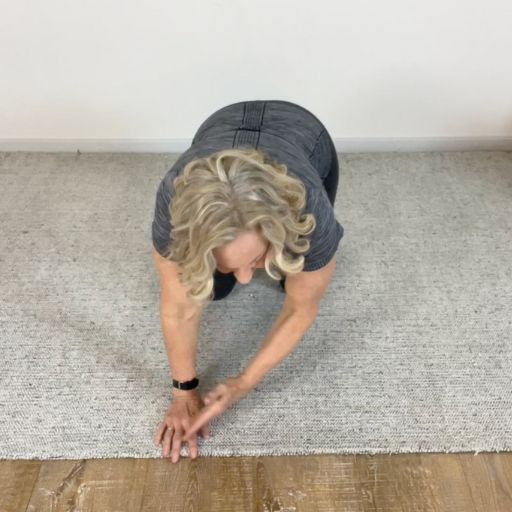
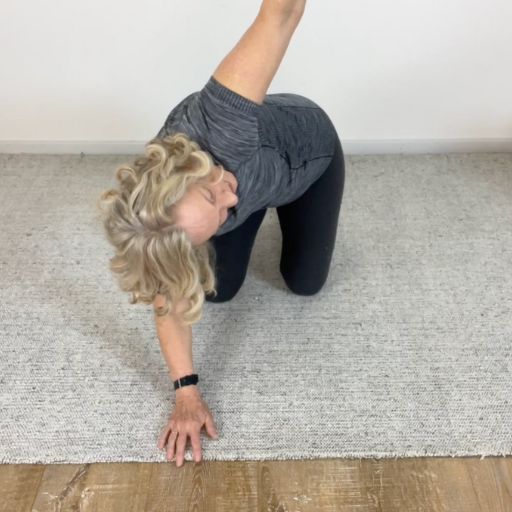
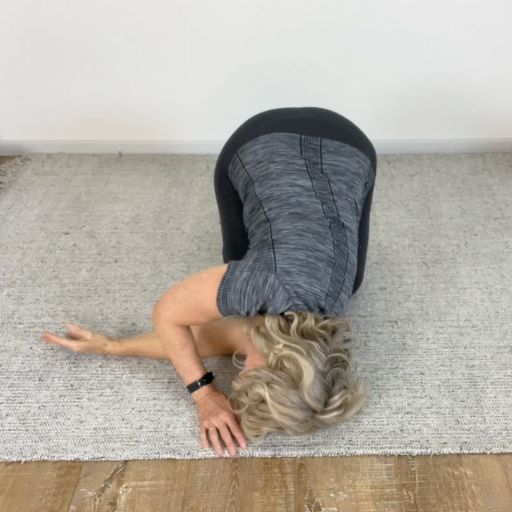
- And one more thing that we can be doing here is taking an arm up
- We'll reach it right up to the ceiling
- And then we're going to reach this arm under as far as we can, lie down on that shoulder. So, I've got that shoulder right under here, reaching up again and having that shoulder come right under
Workout: 9-Minute Repeatable Routine
Enjoy this Kettlebell Overhead Lift 'Overhead-Press' strengthening workout, that Coach Sheree has put together, to compliment this Overhead Lifting Shoulder Exercises for women Over 50, post.
For a WARM-UP do some on the spot marching, with arms moving/swinging for 2-3 minutes before you start the workout. The warn-up intent is to simply get the blood flowing across your body and muscles.
This overhead press strengthening workout has been designed for those who struggle with everyday shoulder movements, and know they need to gain the strength and mobility to the gain freedom, independence and safety they desire.
Workout timestamps:
Timer 30 seconds workout, and 10 seconds rest between.
14:51 - Overhead Press
- Description: Pressing a kettlebell or dumbbell straight overhead while engaging core and glutes.
- Real-Life Gain: Helps with tasks like putting away heavy dishes or lifting items to high shelves.
- Body Strength Gain: Shoulders, upper back, triceps, and core stability.
15:31 - Bent Over Row Both Sides
- Description: Pulling a weight towards the ribcage while bracing with one hand on the opposite leg.
- Real-Life Gain: Improves pulling strength for things like opening heavy doors or picking up shopping bags.
- Body Strength Gain: Upper back, lats, and core.
16:51 - One-Arm Overhead Press Both Sides
- Description: Single-arm press requiring more core engagement to stabilize uneven load.
- Real-Life Gain: Helps with asymmetrical tasks like lifting a child or suitcase with one hand.
- Body Strength Gain: Shoulders, triceps, and deep core.
18:11 - Upright Row
- Description: Lifting weight up to chest height with elbows leading the motion.
- Real-Life Gain: Supports strength for lifting grocery bags or household items to counter height.
- Body Strength Gain: Upper traps, shoulders, and upper body.
18:51 - Overhead Press
- Description: Same as earlier one-arm press, alternating to maintain symmetry.
- Real-Life Gain: Balances strength between dominant and non-dominant arm for daily tasks.
- Body Strength Gain: Shoulders and core.
19:31 - Side Lunge with Row Both Sides
- Description: Step to side while pulling weight upward, mimicking rotational pulling motion.
- Real-Life Gain: Helps with moving laundry baskets or gardening tasks that involve bending and pulling.
- Body Strength Gain: Glutes, quads, hamstrings, back, and core.
20:51 - One-Arm Overhead Press Both Sides
- Description: Repeat of the single-arm overhead press focusing on form and fatigue management.
- Real-Life Gain: Continues to train control and stamina for high-reaching tasks.
- Body Strength Gain: Shoulders, triceps, core.
22:11 - Overhead Tricep Extension
- Description: Lifting a weight overhead and lowering behind head with elbows close.
- Real-Life Gain: Supports overhead control like lowering a grandchild from shoulders or lifting overhead items down safely.
- Body Strength Gain: Triceps, shoulders, and posture muscles.
Final Thoughts
Oh my, I don't know how you're feeling at home but I'm feeling rather tired and my shoulders have just done a great workout. So, well done on your effort there. I'll just turn off my timer.
So, good job. We're trying to go through all the different movements that we feel are the 12 most important movements as you get older. And look, this one can be hard because so many people have problems with their shoulders.
But if you can get a bit of mobility into them, a bit of strengthening into them, you will be amazed at what you can do. So, thank you for joining me and I look forward to seeing you next time.
Additional OVERHEAD-PRESS Related Post/Video Resources: CLICK Image/Link:
Sources & Additional Reading:
- 1Effects of resistance training on body composition and functional capacity among sarcopenic obese residents in long-term care facilities: a preliminary study
https://bmcgeriatr.biomedcentral.com/articles/10.1186/s12877-018-0714-6 - 2Effects of elastic band resistance training on the physical and mental health of elderly individuals: A mixed methods systematic review
https://journals.plos.org/plosone/article?id=10.1371%2Fjournal.pone.0303372 - 3Strength Training to Prevent Falls in Older Adults: A Systematic Review with Meta-Analysis of Randomized Controlled Trials
https://www.mdpi.com/2077-0383/10/14/3184 - 4Heavy resistance training at retirement age induces 4-year lasting beneficial effects in muscle strength: a long-term follow-up of an RCT
https://bmjopensem.bmj.com/content/10/2/e001899
